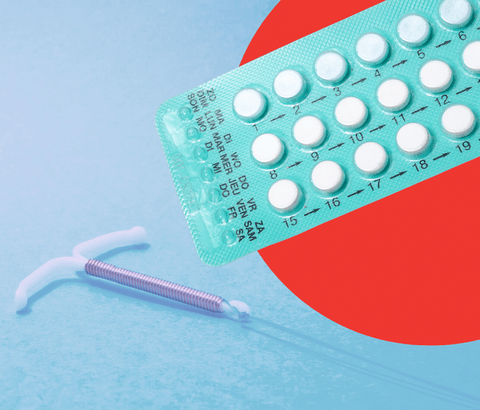What is PMDD?
PMDD stands for Premenstrual Dysphoric Disorder, and it is a much more severe form of PMS, including the possibility of panic attacks or suicidal ideation. People with PMDD may exhibit symptoms of other mental illnesses like anxiety and depression, but only for the 1-2 weeks leading up to their period.
Compared to Premenstrual Syndrome, or PMS, PMDD is much more intense. Both emotional symptoms and physical symptoms can be extremely difficult to manage. However, many of the symptoms for PMS and PMDD look extremely similar. So how do we tell the difference? Consult our PMDD symptoms chart below to learn more.

Why does PMS and PMDD happen?
The menstrual cycle consists of 4 distinct phases: menstrual, follicular, ovulatory, and luteal. The first phase starts on "day 1" at the start of the menstrual period (aka when bleeding first starts). The ovulatory phase happens when an egg is released to be fertilized. The follicular phase is when your body "preps" to ovulate, and the luteal phase is when your body "preps" for your period.
The luteal phase is defined by the hormone progesterone. Progesterone is responsible for a lot of the benefits of having a menstrual cycle and high levels of progesterone are connected to improved mood. [1]
In the second half of the luteal phase, progesterone levels drop and remain low through the first few days of your period. When those levels drop, moods drop with it. These hormone changes are the root cause of mood swings and other mood-related symptoms. [2] The following symptoms are common indicators of PMS and PMDD.
Common symptoms for PMS include:
tension or anxious thoughts
crying
irritability
anger
food cravings
brain fog or difficulty concentrating
headache
fatigue
hormonal acne
breast tenderness
[3]
Common symptoms for PMDD include:
depressed mood
anxiety (including anxiety or panic attacks)
suicidal thoughts
brain fog or difficulty concentrating
headache
fatigue
hormonal acne
breast tenderness
[4]
It can be difficult to navigate between these two disorders because the symptoms are frustratingly similar. How can we know when it's mood swings versus a mood disorder?
The answer isn't clear cut, but ultimately it comes down to how severe symptoms are and whether they keep you from daily life. PMS may be irritating, but should never be disruptive. [5]
Keep reading to dive into some common symptoms and compare how they may look for Premenstrual Dysphoric Disorder (PMDD) versus Premenstrual Syndrome (PMS).
Symptoms, explained.
Mood Swings (and other mood symptoms)

FOR PMS
You feel irksome. Picture reading into a work colleague's punctuation usage in an email or getting upset when your partner forgets something at the store.
FOR PMDD
You feel detached, agitated, or out of control. Picture intense crying, a depressed mood, losing your temper, or having suicidal thoughts.
Fatigue
FOR PMS
You feel sleepier than usual. You might struggle to get up for your alarm, schedule in a nap, or crave an extra cup of joe.
FOR PMDD
You experience intense exhaustion. You need to skip out on work, class, or the gym to rest. You might feel weak or sluggish when you do power through to other tasks.
Physical Symptoms

FOR PMS
You may have headaches, bloating, acne, tender breasts, food cravings, and more, but usually only a couple at a time. When you experience them, they are easily addressed.
FOR PMDD
You may have almost all of the PMS symptoms listed above, or experience even more intense physical symptoms such as insomnia and joint pain.
Anxiety
FOR PMS
You feel more easily overwhelmed or nervous than usual, but not to the point where you reschedule or cancel plans. Picture opting out of a night out to have a movie night with a few friends.
FOR PMDD
You feel intensely overwhelmed, even to the point of an anxiety or panic attack. You may cancel plans or schedule events around the anticipation of your PMS. Picture being diagnosed with an anxiety disorder or other mental health disorders (such as bipolar disorder or a depressive disorder) because you experience this mood-related symptom in the week before your period.
Solutions
If reading these examples makes you think you may have PMDD, don't fret. This disorder has many effective treatment options and there are OBGYNs, therapists, and other medical professionals who specialize in treating PMDD.
The most common and effective treatments include hormonal birth control, SSRIs, dietary supplements, and lifestyle changes such as talk therapy, exercise, or meditation.
Hormonal Birth Control
Hormonal birth control is currently the top recommended intervention for PMDD. Birth control pills that contain drospirenone (such as Yaz) have been proven to be most effective, but other options such as a progestin-only pill may also reduce symptoms. Those who are hesitant to use hormonal interventions may find success with a copper IUD. [6]
Selective Serotonin Reuptake Inhibitors (SSRIs)
Serotonin levels naturally change throughout the menstrual cycle, but in individuals with PMDD it may hit a significant low during the luteal phase. Research shows that SSRIs are effective for treating PMDD. They can be paired with birth control pills or prescribed individually. [6]
Dietary Supplements
While the exact cause of PMDD isn't proven, studies have tested supplementation to support mood symptoms. Vitamin B6 and Magnesium have both been proven to have an effective impact on PMDD mood swings. [7] [8] [9]
You can find both Vitamin B and Magnesium (plus tons of other clinically researched, mood supporting ingredients!) in Steady Mood by De Lune. When taken daily throughout the entire hormonal cycle, 84% of customers report a significant improvement in mood symptoms during their luteal phase.

Lifestyle Changes
There are a handful of activities that can have a positive impact on PMDD symptoms when incorporated into your daily activities. While these may not be enough to manage symptoms on their own, they can be extremely effective when paired with the treatments listed above.
Exercise
Regular exercise has known benefits on dopamine production and for managing depression. It can also improve hormonal balance, which creates a halo effect for every phase of your menstrual cycle.
Meditation
Mindset tools can help manage anxiety, mood swings, and irritability. While a daily meditation practice may not decrease the intensity of emotional symptoms, you will be better equipped to work through them when they arise.
Therapy
Much like the application of therapy in treating mental disorders, anxiety, and depression, it can be a valuable treatment for PMDD. Working with a therapist who is well versed in anxiety and depression will help build out a toolbox to handle symptoms more effectively.
When do symptoms stop being "normal"?
If your PMS is affecting your day-to-day functioning, talk to your doctor about PMDD. It's important to understand that while individuals with PMDD may feel totally normal during the other 3 phrases, the severe symptoms experienced during the luteal phase should not be ignored. With the impact PMDD has on mood and the ability to continue in daily life, consulting a medical professional is important.
When adequate treatment is pursued, it's entirely possible to manage PMDD and have no major impacts on day-to-day life. With time and support, you'll be able to get a handle on your PMDD and get back to daily activities.
References
1. https://my.clevelandclinic.org/health/body/24562-progesterone2. https://www.ncbi.nlm.nih.gov/pmc/articles/PMC6831719/
3. https://www.mayoclinic.org/diseases-conditions/premenstrual-syndrome/symptoms-causes/syc-20376780
4. https://my.clevelandclinic.org/health/articles/9132-premenstrual-dysphoric-disorder-pmdd
5. https://www.mayoclinic.org/diseases-conditions/premenstrual-syndrome/expert-answers/pmdd/faq-20058315
6. https://www.ncbi.nlm.nih.gov/pmc/articles/PMC6759213/
7. Diegoli, M. S. C., Da Fonseca, A. M., Diegoli, C. A., & Pinotti, J. A. (1998). A double‐blind trial of four medications to treat severe premenstrual syndrome.International Journal of Gynecology & Obstetrics,62(1), 63-67
8. Ebrahimi, E., Motlagh, S. K., Nemati, S., & Tavakoli, Z. (2012). Effects of magnesium and vitamin b6 on the severity of premenstrual syndrome symptoms.Journal of caring sciences,1(4), 183
9. Facchinetti, F., Borella, P., Sances, G., Fioroni, L., Nappi, R. E., & Genazzani, A. R. (1991). Oral magnesium successfully relieves premenstrual mood changes.Obstetrics and Gynecology,78(2), 177-181







